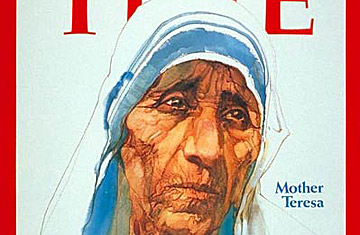
Mother Teresa
(7 of 10)
This same serenity marks Surgeon Carl Becker of the Protestant Africa Inland Mission, who has spent 46 years in the interior of Zaire. Hopping by plane from outpost to outpost, Becker once routinely performed up to 15 major operations a day. Now 81, he continues to work at a large new center at Nyankunde, awaking at 5 a.m. to pray with his staff before his rounds. He and his ailing wife Maria may soon leave Africa. The Zaireans would like to see the couple ultimately buried there—a great tribute to whites—but the Beckers do not want to become burdensome invalids for the hospital.
To Dr. Cicely Saunders of London, her Anglican faith is essential to her work in the St. Christopher's Hospice she founded there. Like Mother Teresa's Nirmal Hriday, it is a home for the dying—cancer patients whom Dr. Saunders treats with heroin and other drugs to ease the pain of their last days. The hospital is cheerful, even gay; patients nibble sweets, chat with visitors, have a drink if they want to. Dr. Sanders, 59, concedes that she could not maintain that atmosphere nor watch her patients die without her faith. "It makes a difference as a very frightened lady drops into unconsciousness that I believe in a religion which speaks of a God who dies, and rises."
Early experience as a victim has moved some medical saints to serve others. As a girl, Yaeko Ibuka was sent to a leprosarium near Mount Fuji. There she became a Catholic and resigned herself to disfigurement and death, only to be told that she did not have leprosy after all. Though free to return home, she says, she "understood for the first time the power of God's love," and stayed. Now, 55 years later, Yaeko Ibuka is known as "the angel of Fukusei Byoin." At 78, she continues to offer her gentle, unstinting care to the lepers.
Schwester Selma Mayer of Jerusalem, 92, is also revered as something of an angel, certainly as a zaddik. She lost her mother when she was five, and as she grew up she became determined "to give to others what I had missed—mother love and concern for human beings." Schwester Selma was nursing in
Hamburg when the head of Jerusalem's Shaare Zedek Hospital came looking for a head nurse in 1916. Through wars and epidemics she has been in Jerusalem ever since, always living at the hospital, often sitting up all night with a critically ill patient. She never married, seeing the care of the suffering as her "duty —one that took up all my time." But she did adopt and raise two daughters who had been orphaned like herself.
To other living saints, giving means devoting their lives entirely to the needs of orphans. Austrian Catholic Hermann Gmeiner, 56, saw that need in the wake of World War II, when Europe was crowded with homeless refugee children. He took a leaf from his childhood—an older sister had raised the eight other children after his mother died—and built the first in a series of "S O S villages" that now care for 15,000 orphans round the world. Every village consists of a cluster of houses, each presided over by a foster mother who cares for eight to ten orphans. They grow up as a family, even attending local schools. Gmeiner asks his foster mothers not to marry lest their commitment become divided. In turn, he has remained unmarried.
